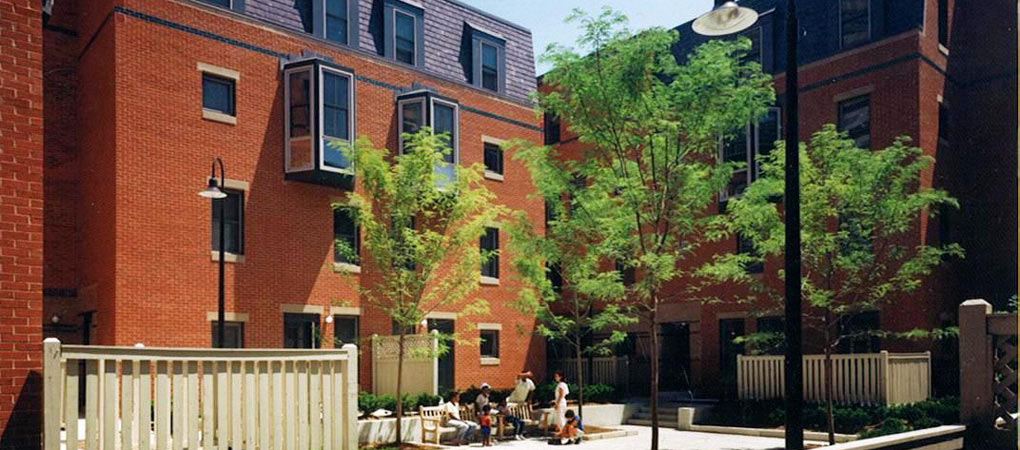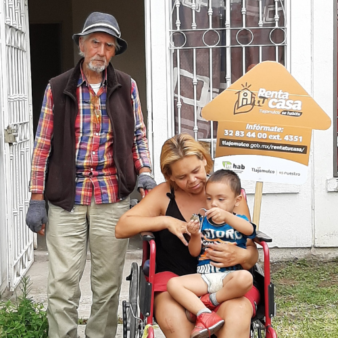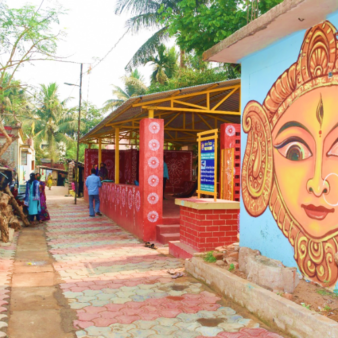Located on the north-east seaboard of the United States of America, Boston is one of the wealthiest and most attractive of American cities. It is comparatively small, with a population of only 600,000 but is of national importance as an historic and academic centre. Like many cities however, its inner city contains areas of poverty and deprivation adjoining areas of extreme affluence. It is in one such area that the Tent City Project is located.
The Tent City Housing originated over twenty-five years ago when a misguided redevelopment programme cleared the site of existing low-income housing to make way for large scale commercial development. At one point, much of the 3.3 acre site was scheduled for a seven storey car park. Residents in the neighbourhood protested against the demolition and demanded replacement of affordable neighbourhood housing. The name Tent City recalls that protest and the community’s eventual success in achieving its goals. In the mid-1980s with the help of the newly elected mayor the city’s urban renewal authority negotiated an agreement whereby affordable replacement housing could be built on the site.
The aims of the project were to create an affordable, mixed-income, racially and ethnically integrated housing community to replace housing lost to urban renewal clearance. Also to help create a residential neighbourhood which would become an integral part of the South End community, by including neighbourhood shops, pre-school day care facilities and a community meeting room, all to serve both the Tent City Housing and the greater community. It was also considered essential to establish an organisation and structure which could sustain these goals into the future, through adequate funding and proper management.
The overall architectural and planning objective in the design of Tent City was to create a human scaled urban living environment which not only blended new construction into an existing urban fabric but which had been achieved within strict budget limitations, thus enabling affordable housing to be retained in wealthy inner city districts. The innovative and historically appropriate design by the architectural firm, Goody, Clancy and Associates has been commended both nationally and internationally.
The twelve storey section of the complex contains 176 one and two bedroom flats and 6,500 ft2 of ground level retail space. The remaining part of the complex consists of four storey townhouses which contain 93 three and four-bedroom duplex apartments and one retail space. The density is 84 units per acre but the excellent design manages to retain a sense of space. Construction is in red brick with contrasting coloured brick trim. Bay windows, mansard roofs and front stoops typical of the neighbourhood characterise the project. Dwellings are arranged around an interior loop road and courtyard containing landscaped open space, play areas and parking. The housing, shops and interior landscaped courtyards are built upon an underground garage for 698 cars.
Tent City was designed using strict energy saving standards, including extremely high insulation standards for walls and windows and water conserving water closets. This design has proved highly successful. Consumption of water, gas and electricity is monitored and consumption is found to be significantly lower than in other similar projects in the locality.
One of the key innovative features of the Tent City project is the financial structure, where cross subsidy enables three quarters of the dwellings to remain affordable to those on low and middle incomes. The financial structure is complex, involving funds from more than 13 sources to fund the capital costs of US$36 million development. These funds are being repaid out of the permanent mortgage loan and syndication proceeds. Four subsidy programs provide rental subsidies to tenants in order to help keep the rents to affordable levels.
Some 25 per cent of the 269 resident households are low income i.e. their incomes are 50 per cent or less of the city’s median household income. Fifty per cent of the units are set aside for moderate income households i.e. where incomes are 50 – 120 per cent of the city median. Within this 50 per cent category, four layers of income ranges must be represented. It has been found that such mixed income developments work better where there is a continuum of incomes, rather than just two disparate groups. The remaining 25 per cent are market rate rents. There is no differentiation between the units according to rent paid.
The ethnic mix reflects that of the local area. Priority for the subsidised units is given, in order, to people displaced by public action, South End residents and people living in sub-standard housing. Market rents are currently US$1,600 per month and 54 of the 77 market rent units are occupied by students (normally two or three per unit). The students integrate well into the project and special care is taken to ensure relative peace and quiet during examination periods. Gentrification is not a problem since the market rent flats are not being invaded by wealthy professionals. Virtually all of the low income households are headed by single parents. After school programs have been established and are increasingly used by mothers, thus enabling them to work and keep off welfare support. Great care is taken in the selection of new residents to ensure credit worthiness i.e. no previous convictions for bad debt, crime etc.
The Tent City Housing shows how a successful development can change public policy. The struggle to build Tent City helped to change Boston’s policies toward housing from that of developing luxury housing towards an integrated approach to housing provision, with emphasis on retaining affordable mixed-income housing in inner city areas. Similar projects are currently being developed elsewhere in Boston, designed by the same architects and involving the same community builders who worked on Tent City.
Partnership
NGO, academic/research, local community



